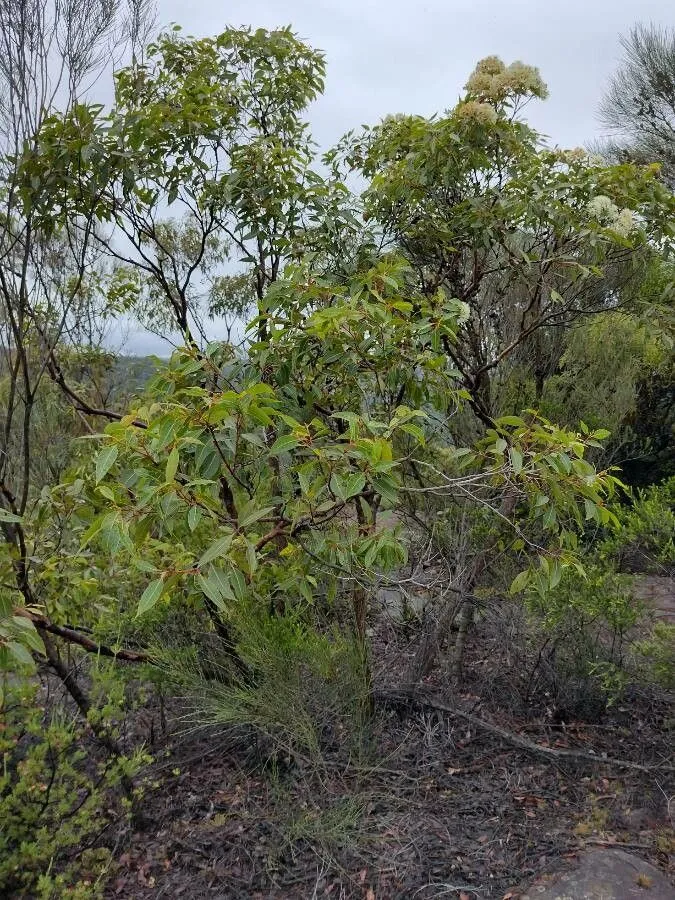
Author: (Gaertn.) K.D.Hill & L.A.S.Johnson
Bibliography: Telopea 6: 233 (1995)
Year: 1995
Status: accepted
Rank: species
Genus: Corymbia
Vegetable: False
Observations: E. & SE. Australia
Red bloodwood is a captivating tree species native to the eastern and southeastern regions of Australia. Officially recognized in botanical circles under the scientific name Corymbia gummifera, this tree is a member of the Myrtaceae family. The species was taxonomically categorized and described by K.D. Hill and L.A.S. Johnson, with its formal classification appearing in Telopea, a respected botanical journal, in 1995.
A dominant feature of the Australian landscape, the Red bloodwood thrives in a variety of environments from coastal regions to the edges of the Great Dividing Range. Its adaptability and resilience make it a common tree in these areas, often defining the local flora with its distinctive reddish bark and robust structure.
Characterized by a rough, tessellated bark that sheds in patches, the Red bloodwood’s appearance is both rugged and striking. Its foliage consists of lance-shaped leaves that are a vibrant green, providing a stark contrast to the rough texture of the bark. During its blooming season, the tree displays clusters of creamy white flowers that attract a myriad of local wildlife, including bees and birds, thanks to the nectar-rich blossoms.
Beyond its aesthetic appeal and ecological contributions, Corymbia gummifera holds cultural and practical significance. Indigenous communities have traditionally utilized various parts of the tree for medicinal purposes, as well as for creating tools and other functional items. The wood itself, valued for its strength and durability, has been used in a variety of applications from construction to crafting.
In the broader ecological system, the Red bloodwood plays an essential role. It contributes to the stability of the soil, provides habitat and food for numerous species, and forms part of the intricate tapestry of Australia’s native forests. Its resilience against environmental stresses, including drought and fire, exemplifies the hardiness of many Australian native plants and highlights its importance in landscape restoration projects.
In summary, the Red bloodwood (Corymbia gummifera) stands as a remarkable representative of Australia’s rich botanical heritage. With its distinctive appearance, ecological value, and cultural significance, it remains an enduring feature of the Australian environment, contributing to the natural beauty and balance of its native landscapes.
Eng: red bloodwood
Por: bloodwood-tree, eucalipto, red-bloodwood
En: Red bloodwood
Pt: Bloodwood-tree, Eucalipto, Red-bloodwood
© copyright of the Board of Trustees of the Royal Botanic Gardens, Kew.
Taken Feb 26, 2022 by Boris Therock (cc-by-sa)
Taken Feb 26, 2022 by Boris Therock (cc-by-sa)
Taken Feb 26, 2022 by Boris Therock (cc-by-sa)
Taken Feb 26, 2022 by Boris Therock (cc-by-sa)
Taken Feb 26, 2022 by Boris Therock (cc-by-sa)
Taken Feb 26, 2022 by Boris Therock (cc-by-sa)
Growth habit: Tree
Family: Myrtaceae Author: (F.Muell.) K.D.Hill & L.A.S.Johnson Bibliography: Telopea 6: 402 (1995) Year: 1995 Status:…
Family: Rubiaceae Author: Pierre ex A.Froehner Bibliography: Notizbl. Bot. Gart. Berlin-Dahlem 1: 237 (1897) Year:…
Family: Sapindaceae Author: Koidz. Bibliography: J. Coll. Sci. Imp. Univ. Tokyo 32(1): 38 (1911) Year:…
Family: Asteraceae Author: A.Gray Bibliography: Pacif. Railr. Rep.: 107 (1857) Year: 1857 Status: accepted Rank:…
Family: Fabaceae Author: Medik. Bibliography: Vorles. Churpfälz. Phys.-Ökon. Ges. 2: 398 (1787) Year: 1787 Status:…
Family: Aspleniaceae Author: (Cav.) Alston Bibliography: Bull. Misc. Inform. Kew 1932: 309 (1932) Year: 1932…